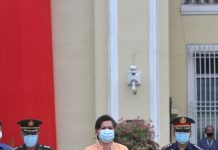The Mines and Geosciences Bureau (MGB) will expand its information dissemination activities to better warn people nationwide about water-induced geohazards in their areas, believing this can help lessen loss of life, limb and property during disasters.
“We’ll launch in March this year a website dedicated to information on geohazards nationwide to help facilitate the search for data on the matter,” said MGB supervising science research specialist Dr. Karlo Queaño.
He said MGB will also mobilize a quick response team that’ll monitor updates on weather disturbances around the country so the agency can immediately issue advisories on possible flooding and/or landslide in areas concerned.
“Our aim is to dish out the information as the weather updates come,” he said.
Government is stepping up its disaster risk reduction and management (DRRM) measures as experts warned climate change will bring forth sea level rise and more violent weather disturbances, resulting in flooding and other calamities.
“We’re already amidst climate change so more of these can be expected,” said River Basin Control Office (RBCO) Executive Director Vicente Tuddao Jr.
He noted rainfall during storm “Sendong” was such that the flow rate in Cagayan de Oro River surged to an estimated 7,200 cubic meters per hour.
RBCO’s estimated flow rate in Mandulug River Basin also rose to some 4,300 cubic meters per hour when “Sendong” struck there in December 2011, he added.
“Normal flow rate in both locations is only about 10 percent of what RBCO estimated there,” he said.
Iligan City and Cagayan de Oro City are among the areas that reeled from flooding and other hardships due to the onslaught of “Sendong.”
Earlier, MGB commenced preparing maps identifying geohazards nationwide so local government units can use these in preparing their respective DRRM plans.
The agency divided the country into quadrangular sections and prepared the corresponding geohazard map for each of these.
MGB reported already completing 730 of such quadrangle maps drawn to scale 1:50,000 meters.
“People will see such maps in the forthcoming website — we’ll show these documents in high resolution,” Queaño said.
He said people can click on any barangay or village shown on any uploaded geohazard map to access more information on that area’s susceptibility to floods and landslides.
“By this March’s end, we aim to finish uploading data on geohazards in all villages nationwide,” he noted.
The Philippines has 42,025 villages nationwide, including those in the Autonomous Region in Muslim Mindanao (ARMM), MGB said.
MGB will soon announce the address of its geohazards website.
“That website will be linked to MGB’s own website,” Queaño said.
He also said MGB will continue gathering information on water-induced geohazards nationwide so the agency can present in the forthcoming website the most up-to-date data possible.
“We’ll continuously update data there as soon as we have new information,” he said. [PNA]
0 Comments
Oldest






